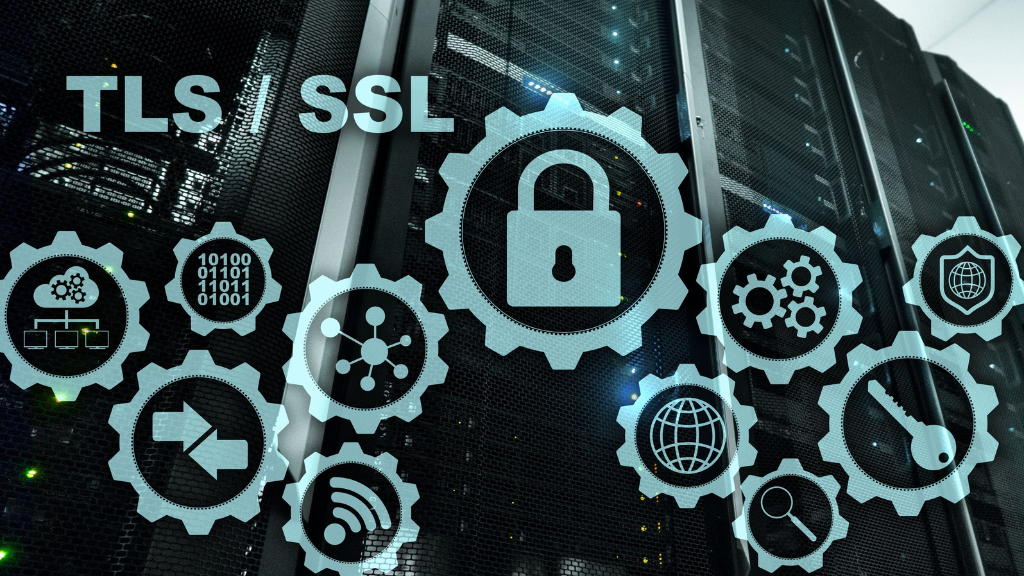Transport Layer Security (TLS) is a cryptographic protocol that provides secure communication over computer networks. It is the successor to the Secure Sockets Layer (SSL) protocol and has become the de facto standard for securing data transmission across the internet.
How TLS Works
TLS operates through a handshake process where a secure connection is established between two parties. First a key exchange occurs between the client and server using an asymmetric algorithm such as RSA or Elliptic Curve Diffie-Hellman (ECDH). After the key exchange, communication occurs using a symmetric algorithm such as Advanced Encryption Standard (AES).
The steps are as follows:
- The client initiates the connection by sending a “hello” message that lists the cryptographic algorithms (cipher suites) it supports.
- The server responds by selecting a mutually supported cipher suite and sending its digital certificate. This certificate contains the server’s public key and is signed by a trusted Certificate Authority (CA) which verifies the server’s identity.
- The client verifies the server’s certificate and generates a pre-master key which is encrypted using the server’s public key. The client sends the encrypted pre-master key to the server.
- Both the client and the server use the pre-master key to derive a shared secret, called the session key. This session key is used to encrypt and decrypt data during the communication session.
Common Use Cases for TLS
- HTTPS Websites: Securing web browsing and online transactions by encrypting data transmitted between the user’s browser and the web server. This prevents eavesdropping, tampering, and man-in-the-middle attacks.
- Email Communication (SMTP, IMAP, POP3): Encrypting email messages and attachments to protect sensitive information from being intercepted or read by unauthorized parties.
- File Transfers (File Transfer Protocol or FTP): Securing file transfers by encrypting the data in transit and verifying the identity of the server.
- VPN Connections: Creating a secure tunnel between the user’s device and a remote network, encrypting all traffic passing through the tunnel. This protects the user’s data from being intercepted or monitored while using public Wi-Fi networks or other untrusted connections.
- IoT Device Communication: Securing communication between IoT devices and cloud servers by encrypting data and authenticating devices.

Benefits of TLS
TLS provides authentication, encryption, and integrity:
- Authentication: Verifies the identity of the communicating parties, ensuring that the client is connecting to the intended server and not an imposter. This is achieved through the use of digital certificates and public key infrastructure (PKI).
- Encryption: Protects data from unauthorized access by encrypting it using strong cryptographic algorithms. This ensures that even if data is intercepted, it cannot be read or understood by an attacker.
- Integrity: Ensures that data has not been tampered with during transmission. This is achieved by using message authentication codes (MACs), Cyclic Redundancy Checks (CRCs), or other cryptographic checksums which detect any changes to the data.
Best Practices
- Always Use the Latest TLS Version (currently TLS 1.3): Newer versions of TLS offer stronger security and better performance than older versions.
- Implement Proper Certificate Management: This includes obtaining certificates from trusted CAs, keeping them up to date, and revoking them if they are compromised.
- Regular Security Audits and Updates: Regularly audit your systems for vulnerabilities and apply security patches and updates to keep your TLS implementation secure.
- Disable Older, Vulnerable Protocols (SSL, TLS 1.0/1.1): These protocols are known to have security flaws and should be disabled in favor of newer versions.
When to Use TLS
TLS should be implemented in any situation where authentication, encryption, or integrity is required, especially when transmitting sensitive data over untrusted networks:
- Transmitting Sensitive Data: This includes personally identifiable information (PII), login credentials, financial data, or any other data that could cause harm if it were disclosed or modified without authorization.
- Ensuring Data Integrity: When it is crucial to ensure that data has not been tampered with during transmission, such as in financial transactions, software updates, or legal documents.
- Authentication Between Parties: When it is necessary to verify the identity of the parties involved in the communication, such as in online banking, e-commerce, or secure remote access.
- Compliance with Security Regulations: When required to comply with industry or government regulations that mandate the use of encryption and authentication, such as GDPR, HIPAA, or PCI DSS.
Remember that while TLS is a powerful tool for securing network communications, it is just one component of a comprehensive security strategy. It should be combined with other security measures, such as firewalls, intrusion detection systems, and strong access controls, to provide optimal protection.
Modernize your Security with Dojo Five on Your Team
Are you looking for experienced embedded security engineers to join your team? What about network experts to ensure your system is in compliance with government requirements? We can help! Book a call with us to get the conversation started.





